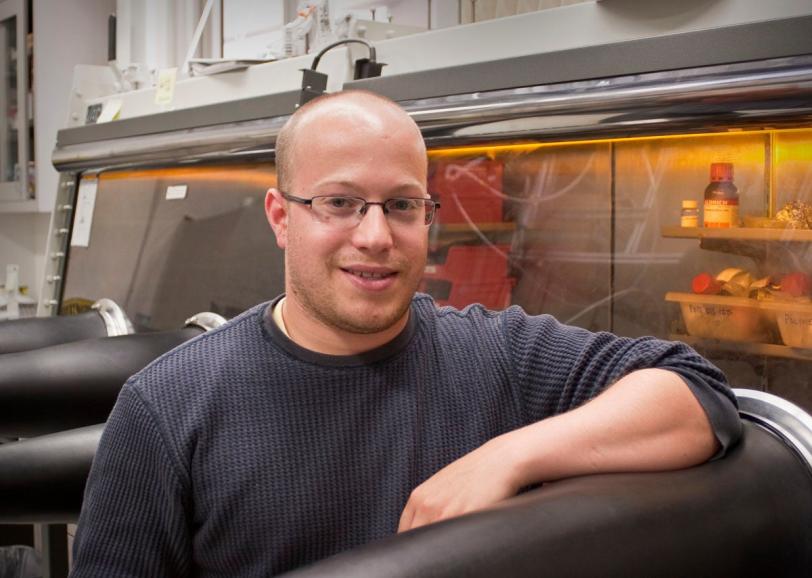Jonathan Rivnay Wins 2011 Klein Award
Jonathan Rivnay, a Stanford graduate student in materials science who has conducted significant research at the Stanford Synchrotron Radiation Lightsource on the relationships between the structure and electrical properties of organic semiconductors, has been selected to receive the 2011 Melvin P. Klein Scientific Development Award.
By Mike Ross
Jonathan Rivnay, a Stanford graduate student in materials science who has conducted significant research at the Stanford Synchrotron Radiation Lightsource on the relationships between the structure and electrical properties of organic semiconductors, has been selected to receive the 2011 Melvin P. Klein Scientific Development Award. Rivnay will receive the award and give a presentation on his research on October 24 at the annual SSRL/Linac Coherent Light Source Users' Meeting.
“It’s fantastic to have my work recognized in this way,” Rivnay said.
Organic semiconductors are the key materials that enable flexible and low-cost electronics such as light-emitting displays, smart sensors and low-cost photovoltaic solar cells.
Using synchrotron radiation scattering as his main tool, Rivnay is applying classic materials science thinking to an area where often scientists think about organic electronics in terms of their electronic properties while being poorly aware, until now, of the importance of the material’s underlying structure.
“Jon has made three very important contributions to his field as a result of his research at SSRL,” said Michael Toney, head of SSRL's Materials Sciences Division.
In 2009 Rivnay reported how the molecular structure between crystalline grains affected current flow within organic semiconductors. Next he showed that the best-performing n-type organic semiconductor was highly crystalline, not amorphous, as had been previously reported. He also demonstrated the unexpected result that when the materials are cast in thin films, they can still have good electrical properties even if the molecules are not lined up perfectly perpendicular to the substrate, which had been thought to be a requirement.
Most recently, Rivnay applied advanced diffraction analysis techniques to determining quantitatively the amount of disorder in organic semiconductors. “We found that many high-performing materials had a significant amount of disorder within their own crystals,” Rivnay said. “For the past five or six years, it’s been solidly rooted in this field that good organic semiconductors need to be as ordered as possible. Indeed, we found that the packing of the crystals is important, but no one had ever looked at how perfect – or not – that packing actually was inside the crystals in the directions important for electronic properties. We found that some types of organic semiconductors are quite disordered. Our results might also explain why some new highly disordered materials are showing very good performance.”
He plans to make his experimental protocols and data analysis code for his new procedure available to the SSRL community.
"This significant accomplishment is even more remarkable since Jon did this with very little input from myself or his advisor,” Toney said. “I just pointed him in the right direction and he developed this methodology largely by himself. He has applied this to numerous samples, and these results have led to several high-impact publications.”
“Jonathan’s work is broadening the materials field and adapting concepts used in different materials systems to organic electronics,” said his advisor, Stanford assistant professor of materials science and engineering, Alberto Salleo. “His research will be useful in the rational design of new materials and is shaping the organic electronic community’s view of the usefulness of synchrotron-based x-ray diffraction.”
Rivnay received his B.S. in materials science and engineering from Cornell University and has been at Stanford since 2007. He has already received the 2010 Robert Huggins Award from the Stanford materials science department and was one of nine to receive the Materials Research Society’s Graduate Student Gold Award in 2011, the highest honor that the society presents to students.
The Klein Scientific Development Award was created in 2006 in the memory of Melvin P. Klein (1921-2000), a pioneer in the use of then-new spectroscopic diagnostic techniques using nuclear magnetic resonance, electron paramagnetic resonance and x-ray absorption. It is given annually to an undergraduate or graduate student or postdoctoral fellow for outstanding research conducted at SSRL. The award comes with a $1,000 prize to help the recipient disseminate his or her scientific results. Rivnay said he’s eyeing a conference at Imperial College in London.
